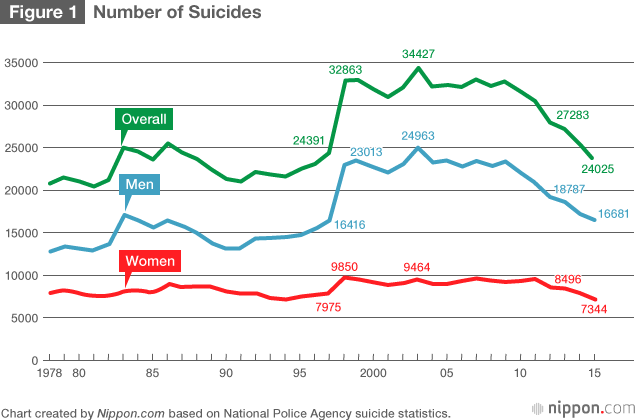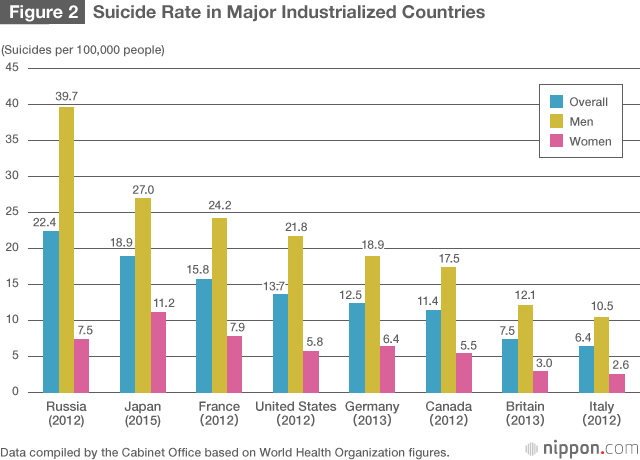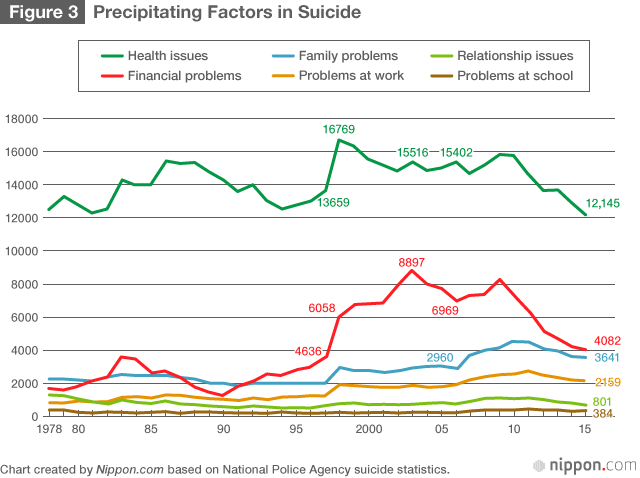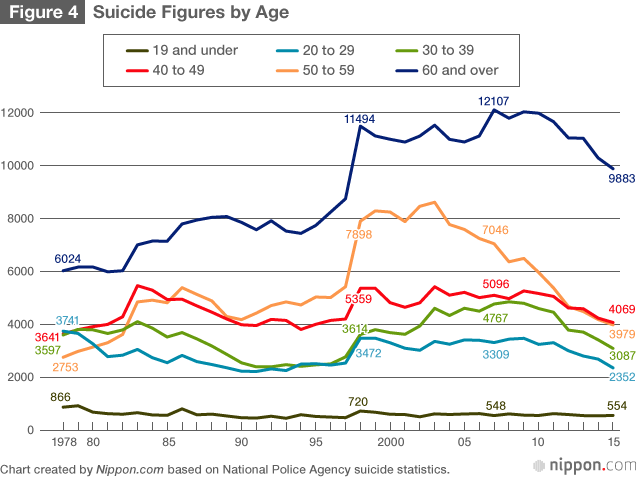
Number of Suicides in Japan Continues to Fall
Society- English
- 日本語
- 简体字
- 繁體字
- Français
- Español
- العربية
- Русский
Suicides under 25,000 for First Time in 18 Years
The Japanese government’s 2016 white paper on suicide prevention found that there were 24,025 suicides in 2015, a decrease of 1,402 compared to the previous year. This marked the fourth consecutive year that the national suicide total was less than 30,000, as well as the first time since 1997 for it to fall below 25,000. There were over 10,000 fewer suicides in 2015 than the peak year of 2003, when 34,427 people ended their own lives. (
Preliminary figuresfor 2016 announced on January 20, 2017, showed a further sharp drop to 21,764.—Ed.)

While the number of suicides fell in 2015, the overall figure was 5.8 times as large as the 4,117 traffic fatalities in the same year. Japan’s rate of 18.9 suicides per 100,000 people remains relatively high compared to other industrialized nations and is more than twice that of Britain and Italy.

Fewer Suicides from Economic Distress
The 2016 white paper included figures on the motivating factors for suicide, with up to three factors listed per case. According to the findings, the most common factor was health issues, accounting for 12,145 suicides in 2015. This was followed by financial problems at 4,082 deaths; family problems at 3,641, problems at work at 2,159, relationship issues, and problems at school. The order of the precipitating factors was basically the same as in previous years. Financial problems was a factor related to only half as many suicides in 2015 as in 2009, when it accounted for around 8,000 suicides.

Leading Cause of Death among Young People
In 2015, men accounted for 69.4% of all suicides, at 16,681 deaths. By age, people in their forties accounted for most suicides, at 16.9% of the total, or 4,069 deaths; followed by those in their fifties (3,979 or 16.6%), sixties (3,973 or 16.5%), and seventies (3,451 or 14.4%). Although the number of suicides for those aged 20 to 79 decreased year-on-year, there was an increase of 3% for youth up to age 19 (at 554 deaths) and of 0.1% for those 80 or over (at 2,459). Those were the only two age groups that saw a rise in suicides.
According to statistics on cause of death for age groups divided into five-year intervals, Japan was the only G7 nation in 2014 to have suicide as the main cause for those aged between 15 and 34.

Health Consultation Reducing Suicides?
The number of suicides in Japan shot up in the late 1990s, against the backdrop of the prolonged recession that followed the collapse of the bubble economy and the tough job market. The rise in suicides led the Diet to pass the Basic Act on Suicide Prevention in 2006, marking the beginning of the government’s full-fledged effort to address the issue.
In 2015, this suicide-prevention effort entered its tenth year. The government 2016 white paper compared the suicide statistics by age bracket in 2007 and 2015. The results showed that suicides had dropped significantly for men in their fifties, but there was a rise among those aged 70 or older as well as a slight increase in suicides among youth.
The white paper suggests that the recent decrease in suicides due to health issues “may be related to improvements in medical treatment for depression and physical ailments as well as enhancement of the health consultation system.”
The report also presented the finding that among those areas facing the problem of depopulation and aging, “the suicide rate is higher in mountainous communities than on remote islands where the residents tend to live closer together.” The white paper recommends the need for preventative measures targeting young people as well as policies aimed at depopulated, aging areas.